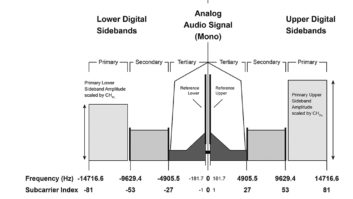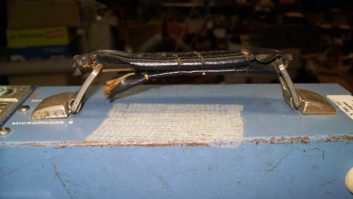The carrying handles on Nems-Clarke 120E or RCA WX-2 Field Intensity Meters are leather-covered spring steel units, certainly state-of-the-art in the 1950s.
Unfortunately, the leather breaks down and falls off. The meters I’ve seen or worked on have had their handles taped up with gaffer’s tape or dozens of layers of electrical tape, in an attempt to keep them attached and functional. Some people take them to leather shops and have them rebuilt or recovered.

Fig. 1: The original leather handle on a WX-2A meter.
For a few dollars and 15 minutes of time, you can replace that old ratty-looking handle with a nice functional and comfortable plastic handle.
I purchased mine on a popular auction site for about $4 plus shipping. Search for “replacement luggage handle” and choose the style and color that suits you. I’d recommend a black or gray plastic handle with silver-colored hinges. I had bought a pair of similar handles for a few dollars more that I used on two other RCA meters. You could also purchase a handle that doesn’t fold down at all. It’s your meter; choose whatever you like.
Procedure
Follow these simple steps to replace the handle.
1. Remove the cabinet from the unit. Unplug the battery cable from the chassis. Put the chassis in a safe place away from the area you’ll be working in.
2. Use a screwdriver to pry the handle’s mounting tabs away from the inside of the top of the cabinet. Then use a pair of stout pliers (lineman’s pliers or Vise-Grips) to bend one tab vertical so the mounting clips can be removed from the slots. Pry the clips out of the cabinet and remove the handle. Discard these parts unless you want to save them for nostalgic purposes. Fig. 2 shows the beginning of this process.

Fig. 2: Begin by bending the tabs away from the inside of the cabinet.
3. Align the new handle with the slots occupied by the original handle and center the mounting holes. Mark them with a center punch (the cabinet is hard steel) and drill the appropriate size holes. I used a 5/32-inch drill to accommodate the #6-32 hardware that fit my handle’s hinges.
4. De-burr the holes inside the cabinet. File them flat if necessary. Blow out all loose metal filings and chips. Clean the inside surface of the cabinet with alcohol (or another strong degreaser) so the tape will stick really well. Here’s the top of the cabinet ready for the handle:

Fig. 3: The original handle is gone and new holes are drilled.
5. Use a 10-inch-long piece of real metal (aluminum) foil tape, the kind used to seal heating ducts, on the inside of the cabinet to cover the old slots and new holes. Poke or re-drill holes through the tape for the screws. On a previously repaired meter I put the tape on after attaching the handle, but it looks better if you put it on first. Here’s the inside prior to the handle being mounted:

Fig. 4: Inside the case with the foil tape covering the openings.
6. Mount the new handle with the appropriate size hardware. I used 3/8-inch-long #6-32 flat-head Phillips-head screws with #6-32 hex nuts. If the handle you buy can’t fold flat in both directions (like the one used on the Potomac Instruments FIM41), make sure it folds flat towards the back of the cabinet so it doesn’t impede normal meter operation or get in the way of the cover/antenna.
7. Optionally, add another piece of tape inside over the new hardware, to keep it from falling into the FIM in case someone decides to loosen it from the outside, or if the screws you use are long enough, add a second nut to each one. You could use locking nuts instead of regular nuts too.
8. Reattach the battery cable. Reinstall the unit into the cabinet.

Fig. 5: Here’s the meter with its new hinged handle standing proud.
Fig. 6 is a family photo, including several RCA meters and a Potomac Instruments FIM-41. All of the RCA meters are using seven 9V batteries for power (see RW, Oct. 19, p. 16). All four meters indicate 180–185 mV/m on one local station, which is surprising considering their ages and dates of calibration.

Fig. 6: From left to right, an RCA WX-2A, an RCA WX-2C, an RCA WX-2D, all with new handles, and a stock Potomac Instruments FIM-41.
The author is amateur radio operator WA1MIK and an FCC licensed contract radio engineer in Southern Connecticut.










